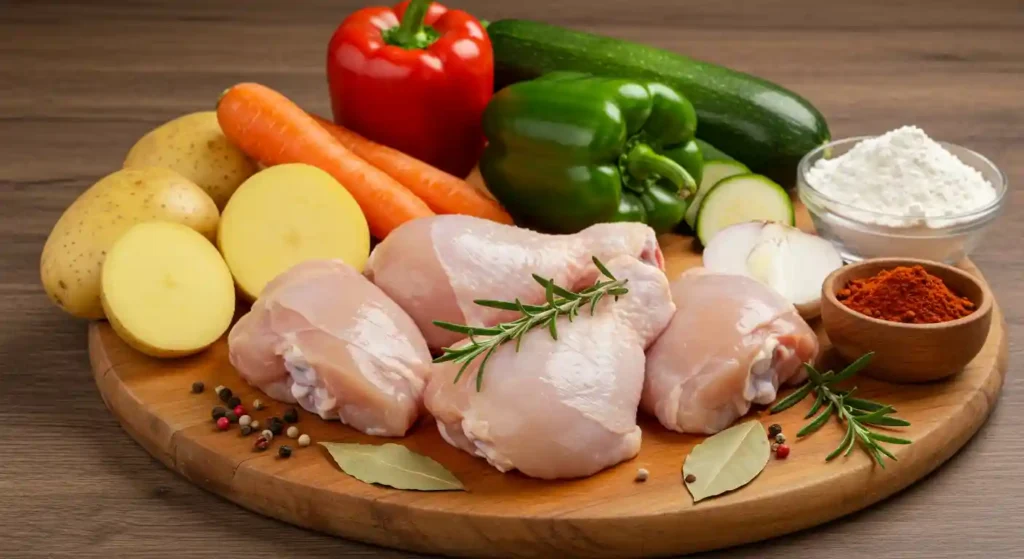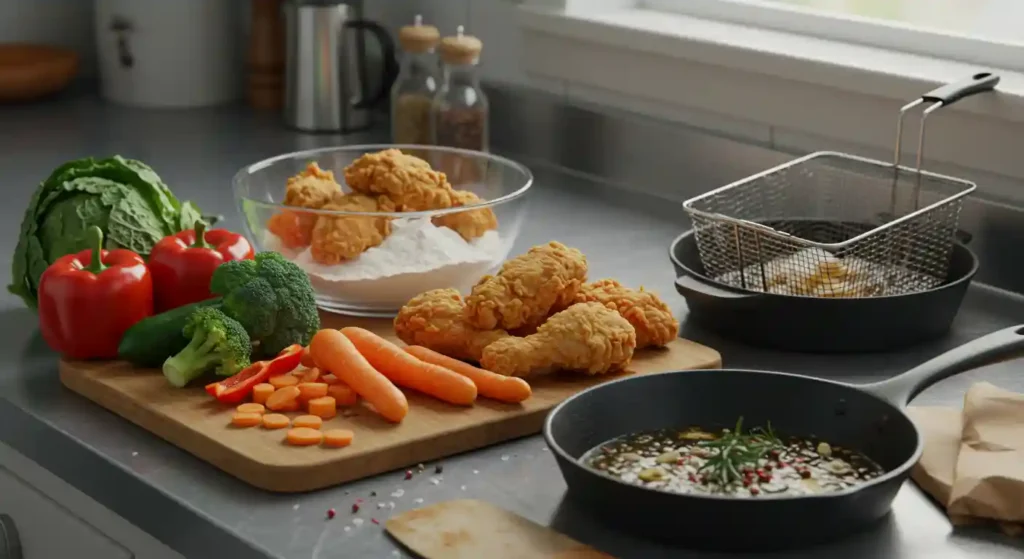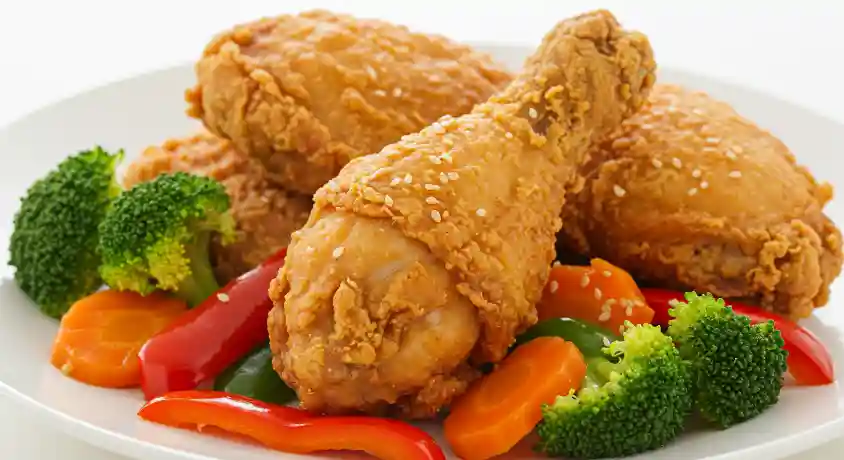Master the Art of Perfectly Crispy
A plate of perfectly crispy fried chicken is irresistible, with its golden, crunchy exterior and tender, juicy meat inside, making every a mouthwatering experience.
This dish has a special place in the hearts of food lovers everywhere, whether it’s enjoyed as a comforting weeknight dinner or served at a celebratory family gathering. Fried chicken is much more than just a meal—it’s a symbol of comfort, tradition, and pure indulgence.
History and Cultural Origin
Fried chicken’s history dates back to Southern cuisine, where it was popularized by African American cooks in the 19th century. The combination of seasoned flour and deep frying techniques made it a unique and flavorful dish. Over time, this Southern classic spread across the United States and around the world, with each region adding its own spin. From the spicy flavors of Nashville hot chicken to the crispy, crunchy variations found in Asian cuisines, fried chicken has evolved while retaining its irresistible appeal.
Personal Story and Reason for Choosing the Recipe
For me, making fried chicken is a cherished family tradition. I remember the first time I perfected this recipe for a family gathering—watching my loved ones enjoy it with delight was an unforgettable experience. After countless attempts and tweaking the seasoning and frying methods, I finally found the perfect balance of crunch and juiciness that brings this dish to life.
Health Benefits and Special Features
While fried chicken is often considered indulgent, there are ways to make it healthier without sacrificing flavor. Opting for lean cuts of chicken, using heart-healthy oils like avocado or olive oil, and controlling the seasoning can make this dish lighter. Best of all, homemade fried chicken allows you to enjoy the crispiness and flavor of fast food but with the satisfaction of knowing it’s made with care and quality ingredients.
Table of Contents
Ingredients for Perfectly Crispy Fried Chicken

To achieve the perfect crispy fried chicken, you’ll need a selection of high-quality ingredients. Here’s what you’ll need:
- Chicken Pieces: Choose bone-in pieces like drumsticks, thighs, or wings for the best results. Bone-in chicken retains more moisture, ensuring a tender and juicy interior. You can also use whole chicken parts if you prefer.
- Buttermilk: Buttermilk adds a tangy flavor and helps tenderize the chicken, making the coating adhere better while frying.
- All-Purpose Flour: Flour forms the base of the coating, creating that golden, crispy crust. For extra crunch, you can mix in a bit of cornstarch.
- Seasonings:
- Paprika: Adds a smoky depth of flavor and enhances the color of the crust.
- Garlic Powder: For an aromatic kick.
- Onion Powder: A subtle sweetness to balance the savory notes.
- Salt and Pepper: Essential for seasoning the chicken and the flour mixture.
- Cayenne Pepper: For a touch of heat (adjust to your spice preference).
- Oil for Frying: Peanut oil is ideal due to its high smoke point, which makes it perfect for deep frying. Alternatively, vegetable oil works just as well.
Ingredient Substitutions
- Gluten-Free Flour: If you have a gluten sensitivity, swap the all-purpose flour with a gluten-free flour blend or rice flour to maintain that crispy coating.
- Dairy-Free Alternative: Instead of buttermilk, you can use a dairy-free substitute like almond milk mixed with a tablespoon of lemon juice or vinegar to mimic the tangy effect.
- Vegetarian Version: For a plant-based alternative, you can use cauliflower or tempeh in place of chicken. Ensure to marinate the substitute in the same flavorful buttermilk mixture and coat it well in the seasoned flour.
Tips for Choosing the Best Ingredients
- Fresh, High-Quality Chicken: Opt for fresh, free-range, or organic chicken for the best flavor and texture. The chicken’s quality directly impacts the final dish, so choose the best you can afford.
- Right Oil for Frying: Peanut oil or vegetable oil are the best options for deep frying because of their high smoke points. Avoid oils with lower smoke points, such as olive oil, as they may burn during the frying process.
- Fresh Spices: The flavor of the seasonings can make a big difference. Using fresh, high-quality paprika, garlic powder, and cayenne will elevate the taste and ensure a more aromatic, flavorful crust.
By selecting top-notch ingredients, you ensure that your fried chicken turns out perfectly crispy, flavorful, and memorable every time!
Instructions: How to Make Perfectly Crispy Fried Chicken

Here’s a step-by-step guide to making the crispiest, juiciest fried chicken that will impress everyone at the table.
1. Preparation: Marinating the Chicken
The first step to tender, flavorful fried chicken is marinating it in buttermilk. This not only tenderizes the meat but also helps the seasonings adhere better to the chicken. Start by placing your chicken pieces (drumsticks, thighs, or wings) in a large bowl or ziplock bag. Pour enough buttermilk to fully submerge the chicken, and add a pinch of salt and pepper for an extra layer of flavor.
Let the chicken marinate in the fridge for at least 2 hours, or overnight if you have the time. The longer the chicken sits in the buttermilk, the more tender and flavorful it will become.
2. Seasoning: Preparing the Flour Mixture
While the chicken is marinating, it’s time to prepare the seasoned flour mixture that will create the crispy, golden crust. In a large mixing bowl, combine:
- 2 cups of all-purpose flour (or gluten-free flour if needed)
- 1 tablespoon of paprika
- 1 teaspoon of garlic powder
- 1 teaspoon of onion powder
- ½ teaspoon of cayenne pepper (for heat, optional)
- 1 teaspoon of salt
- ½ teaspoon of black pepper
Mix everything thoroughly. For an extra crunchy crust, you can add 1/4 cup of cornstarch to the flour mixture. This helps create an even crispier exterior. Set the seasoned flour aside for the coating step.
3. Coating the Chicken
Now it’s time to coat the chicken. Take each marinated piece of chicken out of the buttermilk, allowing any excess liquid to drip off. Next, coat the chicken in the seasoned flour mixture. Be sure to press the flour into the chicken, ensuring it’s fully coated with a thick layer of seasoning.
For an even crunchier coating, after dipping the chicken in the flour mixture, dip it back into the buttermilk briefly and coat it in the flour mixture again. This double coating ensures extra crispiness.
4. Frying: The Perfect Frying Technique
Frying is where the magic happens! Heat a deep skillet or Dutch oven over medium-high heat and add enough oil to submerge the chicken pieces about halfway. You can use peanut oil or vegetable oil for the best results due to their high smoke points.
The ideal frying temperature is around 350°F (175°C). To test the oil, drop a small amount of flour into the pan; if it sizzles immediately, the oil is ready. Carefully add the chicken pieces to the hot oil, but don’t overcrowd the pan. Frying in small batches ensures the oil temperature stays steady, and the chicken fries evenly.
Fry each piece of chicken for about 12-15 minutes, turning occasionally, until the exterior is a deep golden brown, and the internal temperature of the chicken reaches 165°F (75°C). The chicken should be crispy on the outside while remaining juicy and tender on the inside.
5. Draining the Chicken
Once the chicken is done frying, carefully remove it from the oil using tongs or a slotted spoon. Place the fried chicken on a plate lined with paper towels to drain any excess oil. This step is crucial for achieving that crisp, non-greasy skin.
Cooking Tips and Techniques

- Fry in Small Batches: Don’t overcrowd the frying pan. If you add too many pieces at once, the temperature of the oil will drop, resulting in soggy chicken instead of crispy perfection.
- Maintain Oil Temperature: It’s essential to keep the oil at a steady temperature of 350°F. If the oil is too hot, the chicken will burn; if it’s too cool, the chicken will absorb too much oil and become greasy. Use a thermometer to monitor the temperature.
- Allow the chicken to rest for a few minutes after frying before serving. This allows the juices to redistribute, ensuring every bite is juicy and tender.
- Double Dredge for Extra Crisp: For an even crunchier coating, consider dipping the chicken in the buttermilk and flour mixture twice—this adds an extra layer of crunch.
By following these steps and tips, you’ll have perfectly crispy fried chicken that’s tender on the inside and golden brown on the outside, every time.
Tips & Variations for the Perfect Fried Chicken
Dietary Adjustments
While traditional fried chicken is delicious, it can be a bit heavy. Here are a few ways to lighten up the recipe without sacrificing flavor:
- Air Frying: For a healthier alternative, try using an air fryer instead of deep frying. Air frying requires significantly less oil, resulting in a crispy exterior without all the extra calories. Simply coat the chicken as you would for deep frying and cook in the air fryer at 375°F for about 25-30 minutes, turning halfway through.
- Baking: If you prefer to avoid frying altogether, baking your chicken is another great option. Preheat your oven to 400°F, place the coated chicken on a rack (to allow air circulation for crispiness), and bake for 35-40 minutes, flipping the chicken halfway through. You can also spray the chicken with a little olive oil for extra crispiness.
- Using Leaner Cuts: For a healthier version, use skinless chicken breasts or boneless thighs. These options have less fat compared to traditional dark meat, but still offer great flavor and juiciness.
Flavor Enhancements
Elevating the flavor of your fried chicken is easy with some simple adjustments to the seasoning:
- Cajun Seasoning: If you like a bit of heat, try adding Cajun seasoning to your flour mixture. This will give your fried chicken a flavorful, spicy kick that’s perfect for those who love bold flavors.
- Fresh Herbs: Adding fresh herbs such as thyme, rosemary, or sage to the seasoning blend can impart a fragrant, earthy flavor to your chicken. Simply chop the herbs finely and mix them into the flour or sprinkle them on top after frying.
- Lemon Zest: For a refreshing twist, add lemon zest to the flour mixture. The citrusy flavor pairs beautifully with the crispy coating and adds a touch of brightness to the dish.
Serving Suggestions
Fried chicken is incredibly versatile when it comes to sides. Here are some classic and creative ideas to pair with your fried chicken:
- Mashed Potatoes: A creamy side like mashed potatoes is the perfect complement to crispy fried chicken. Top them with some gravy for an extra indulgent touch.
- Coleslaw: A tangy, crunchy coleslaw offers a refreshing contrast to the richness of the fried chicken.
- Cornbread: Serve your fried chicken with warm, buttery cornbread to soak up the flavors and add a bit of sweetness.
- Dipping Sauces: Offer a variety of dipping sauces such as honey mustard, ranch, or a spicy hot sauce to give guests different ways to enjoy their chicken.
With these tips and variations, you can customize your fried chicken to suit any dietary preference, flavor craving, or meal occasion.
Nutritional Information for Crispy Fried Chicken
Caloric and Macronutrient Breakdown
The nutritional information for fried chicken can vary based on the specific ingredients used, including the type of oil and the size of the chicken pieces. Below is an approximate breakdown per serving (one piece of fried chicken, such as a drumstick or thigh):
- Calories: 350-450 kcal
- Fat: 20-25g (depending on the oil used)
- Saturated Fat: 4-6g
- Monounsaturated Fat: 8-10g
- Polyunsaturated Fat: 4-6g
- Protein: 20-25g
- Carbohydrates: 20-25g
- Fiber: 1-2g
- Sugar: 0-1g
Note: The calorie and fat content can be reduced by using leaner cuts of chicken (like skinless chicken breasts) and frying with healthier oils, such as avocado or olive oil. Air frying or baking the chicken can further decrease fat and calories.
Health Benefits of Ingredients

- Chicken: Chicken, especially skinless breast or thigh meat, is an excellent source of high-quality protein, which is essential for muscle repair and growth, immune function, and overall health. It’s also rich in B vitamins (like niacin and B6), which support metabolism and energy production.
- Healthier Oils: The oil used for frying can impact the nutritional profile significantly. Peanut oil and vegetable oil have high smoke points, making them ideal for deep frying, but using healthier oils like avocado oil or olive oil (in moderation) can lower saturated fat content and provide beneficial monounsaturated fats, which are better for heart health. Additionally, using less oil when frying (e.g., in an air fryer) can drastically reduce fat intake.
- Homemade Control: One of the biggest advantages of making fried chicken at home is the ability to control the ingredients. You can opt for organic, free-range chicken and healthy cooking oils to make the dish a more balanced meal. Additionally, using a light, homemade flour mixture allows you to avoid the preservatives and unhealthy additives often found in store-bought breading.
By preparing your fried chicken with these considerations in mind, you can enjoy a satisfying, flavorful meal while keeping the nutritional value in check.
Common Mistakes & Fixes for Perfect Fried Chicken
Mistakes in Preparation
- Not Marinating the Chicken Long Enough
- Mistake: Skipping or rushing the marinating process can result in dry, flavorless chicken. Buttermilk helps tenderize the meat and enhances the flavor, so it’s important to let it soak.
- Solution: Allow the chicken to marinate in the buttermilk for at least 2 hours. If you have time, marinate it overnight to achieve a deeper, more flavorful result. The longer the chicken soaks, the more tender and juicy it will be.
- Overcrowding the Frying Pan
- Mistake: Adding too many pieces of chicken to the pan at once can lower the oil temperature, leading to uneven cooking. This often results in greasy, soggy chicken rather than a crispy exterior.
- Solution: Fry the chicken in small batches, ensuring each piece has enough room to cook evenly. This will help maintain the right oil temperature and achieve the perfect crisp on every piece.
- Using the Wrong Oil Temperature
- Mistake: If the oil is too hot, the chicken may burn on the outside while remaining raw inside. If it’s too cold, the chicken absorbs too much oil and becomes greasy.
- Solution: Use a thermometer to monitor the oil temperature, keeping it steady at 350°F (175°C). If you don’t have a thermometer, drop a small amount of flour into the oil—if it sizzles immediately, the oil is ready.
Fixing Flavor Issues
- Chicken is Bland
- Mistake: Sometimes the chicken can taste too plain if the seasoning isn’t bold enough or hasn’t had enough time to soak in.
- Solution: To enhance flavor, ensure the flour mixture is generously seasoned with salt, pepper, and spices like garlic powder, paprika, and cayenne pepper. Also, marinate the chicken for a longer time to allow the buttermilk to infuse more flavor into the meat.
- The Skin is Not Crispy
- Mistake: The skin can turn soggy if the oil temperature is too low or if the chicken isn’t drained properly.
- Solution: Ensure the oil is at the correct temperature (350°F or 175°C) before frying. After cooking, let the chicken rest on a wire rack or paper towels for a few minutes to allow the excess oil to drain. This step is essential for achieving the perfect crispy texture
By avoiding these common mistakes and following the fixes, you can achieve perfectly crispy, flavorful fried chicken every time.
Frequently Asked Questions (FAQs) for Perfect Fried Chicken
1. How to Store Fried Chicken?
To store leftover fried chicken, place it in an airtight container or wrap it tightly with foil or plastic wrap. Keep it in the fridge for up to 3 days to maintain its flavor and texture. For longer preservation, you can freeze the fried chicken. Simply wrap the pieces in foil or parchment paper, then place them in a freezer-safe bag or container. When properly stored, frozen fried chicken can last for up to 3 months. To reheat, bake it in the oven at 375°F (190°C) for about 20-25 minutes to restore its crispiness.
2. Can I Prepare Fried Chicken in Advance?
Yes, you can prepare fried chicken in advance! Marinating the chicken overnight is a great way to infuse more flavor and tenderness. If you want to fry it ahead of time, simply cook the chicken as you normally would, then allow it to cool completely. When ready to serve, reheat the chicken in the oven at 375°F (190°C) for 10-15 minutes. This helps preserve the crispiness while ensuring the chicken is thoroughly heated. Just be careful not to overheat it, as that can cause the coating to lose its crunch.
3. What Are the Best Additions or Variations?
There are plenty of ways to customize your fried chicken to suit your personal taste! Here are some fun ideas:
- Buttermilk Soak: For an even juicier chicken, you can soak the chicken in buttermilk for longer than usual (up to 24 hours). This gives the chicken more time to absorb the flavors and results in extra tenderness.
- Spicy Fried Chicken: If you love heat, you can add hot sauce directly into the buttermilk marinade or even incorporate it into the flour mixture. This will give the chicken a zesty, spicy kick.
- Herb-Infused Chicken: Add fresh herbs like thyme, rosemary, or oregano to the flour mixture for a fragrant twist.
- Crispier Coating: Experiment with different coatings such as crushed cornflakes or panko breadcrumbs for an even crunchier exterior.
With these additions and variations, you can make the fried chicken your own and adjust it to your flavor preferences!
Conclusion & Call to Action
This crispy fried chicken recipe is a must-try for anyone looking to enjoy the perfect balance of crunchy, golden skin and tender, juicy meat. With its easy-to-follow steps and tips for achieving restaurant-quality results at home, this dish will quickly become a family favorite. Whether you’re serving it for a casual weeknight meal or a special occasion, the irresistible flavors and textures will leave everyone craving more.
We’d love to hear about your experience! If you try this recipe, be sure to share your results in the comments section below. Feel free to include any tweaks or flavor variations you made—we’re always excited to learn from your culinary creativity.
And while you’re here, don’t forget to check out more delicious recipes on the blog! For the perfect sides to pair with your fried chicken, try our creamy mashed potatoes, flaky biscuits, or tangy coleslaw. These complementary dishes will elevate your meal and make it even more memorable. Happy cooking, and we can’t wait to see your fried chicken creations!


3 thoughts on “The Best Fried Chicken Every Time”
Comments are closed.